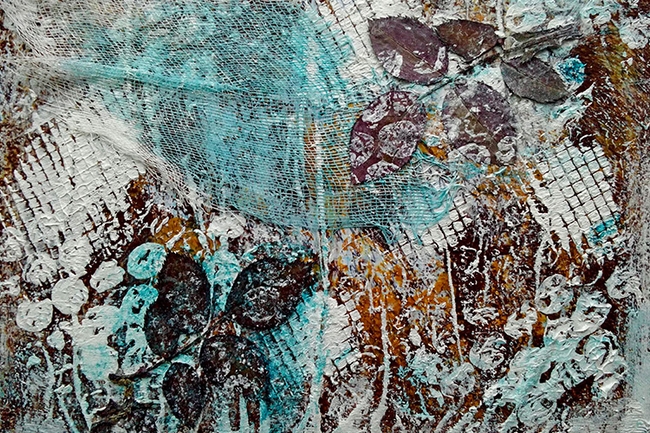What is an Artist Statement?
An artist's statement is as important as an artist's work. Simply put, the artist statement is a brief description of your artworks that shapes the viewers' perspective when they are looking at your art.
Think of it as your substitute when you are not present to answer questions related to your art. Art is subjective. People will look at your craft and evaluate it. So, it helps if you communicate your story to the viewer. Viewers often have questions about the art they are looking at. An effective artist statement answers those questions while you are not there.
Writing an artist statement should ideally be natural and free flowing because essentially, you are expressing your own story. However, it can seem challenging to put one together.
Creative professionals write artist statements as part of their online portfolio. An online portfolio acts as your professional address and launchpad to find work opportunities and recognition. Artist statements go hand-in-hand with a online portfolio website. A website helps you gain credibility and legitimacy. Take a look at some great examples of artist portfolio websites.
Create your artist portfolio website on Pixpa within minutes without any coding. Start your free trial. No credit card required.
Given below are a few valuable tips from professional essay writers that will help you to write a clear, concise, and compelling artist statement. Here are stunning great tattoo artist portfolio website examples designed for your use.
How to write an artist statement – The structure
Your artist statement is about YOU. So you must make it personal. Writing an artist statement is also an exercise for you to clarify your ideas about your work.
- What is the intent and purpose of your art?
- What does it say about you as an artist?
- What keeps you motivated every day?
- What is your artist story?
- What questions are you often asked about your work?
- Who is your audience
You must establish the connection between what you are creating as an artist, and why are you doing it. How are you expressing your ideas with the medium of your choice?
Your artist statement is an introduction to your work and should be no more than 100 -150 words. The opening sentence should be distinct and captivating and draw the readers in. Begin with a short paragraph about the basic premise behind your work, artistic style, and vision. What do you want to say with your art? What is it that makes your work unique? What inspires you? What makes you stand out from the rest of the artists working in your space?
Be honest about your work. Avoid repetition of words. Use simple language and short sentences that draw attention to, and illustrate your ideas to your audience
The next paragraph should be a concise expression of the type of work presented and the artistic process. Describe your job, your favorite colors, and your technique as an. As a photographer, explain your work from a creative and technical standpoint.

An artist statement can be a full-page statement or a short statement, only focusing on your current project.
In a full-page artist statement, do remember to include the following:
- The reason behind creating your work and its history
- Overall vision
- The context of your work -Medium, artistic process, technique, and influences. Highlight what materials you work with and your sources and inspiration
- The expectations of your audience and how they perceive your work
- Your current work’s relation to your previous projects
- How your work fits with current contemporary art practice
Tip: While writing, do remember that you should avoid exaggerated statements and avoid pretentiously grand terms like 'the only one' or the 'best.'
Where is an artist statement used?
Remember, an artist statement complements your bio or resume. It is an opportunity to help the reader envision your work before actually seeing it, and present a picture of who you are as an artist.

Here are a few places where you may need to submit your artist statement:
- To a gallery owner or curator who needs details about your work.
- To a competitive event or an artist collective.
- When applying to graduate school
- When applying for grants or art scholarships
- When applying for a teaching position.
- To a reviewer who is writing about your work for a magazine or catalog.
- As an introduction to your creative work for potential buyers.
Along with your portfolio of works, you must have an artist statement ready at all times. It is the first point of communication between you as an artist and the viewer.
Examples of famous artist statements
Here are some artist statement examples that you can get inspired from:

Andy Warhol, Marilyn Monroe, silkscreen print
"I long for the old days of Marilyn Monroe and Audrey Hepburn, stars who had real glamour and mystique. We only knew so much about their lives; the rest was a mystery… My fascination with letting images repeat and repeat – or in a film's case 'run on' – manifests my belief is that we spend much of our lives seeing without observing."
Leonardo da Vinci, Salvator Mundi. Wikipedia
"The beginnings and ends of shadow lie between the light and darkness and may be infinitely diminished and infinitely increased. Shadow is the means by which bodies display their form. The forms of bodies could not be understood in detail but for shadow."
Painting by Berthe Morisot
"It is important to express oneself… provided the feelings are real and are taken from your own experience… My ambition is limited to capturing something transient, and yet, this ambition is excessive."
From any of the sample artist statements above, you can understand that conveying the purpose of your art and your philosophy towards it is important.
Check out these great examples of artist portfolio websites for your inspiration and further examples of artist statements.
Tips for writing a compelling artist statement:
1. Share the inspiration behind your art
One of the best ways to introduce your art to the viewers is to write about the inspiration behind it. This lays a foundation before you begin to explain your artwork to your viewers. Inspiration can be a daily phenomenon or a particular incident. Regardless, explain it in as simple words as you can. This act accomplishes the principal goal of connecting with the viewer. Not doing so leaves a viewer unconnected, especially if it's abstract art. Without it, your art is a splash of multiple colors on canvas with nothing to make of it.
2. Shape the viewer's perspective
The next important thing to do when you write an artist statement is to explain your art in words that would shape the perspective of viewers. Your art is your viewpoint, and one can easily misunderstand it. To ensure that you and the viewer are on the same page, add a line or two to explain your art. But, restrain from divulging all the details about your work. Try to leave a little room for curiosity such that the viewer is bound to further inquire about your art.
3. Keep the artist statement as small as possible
If you are wondering how long should your artist statement be, then you should know that lengthy biographies drain viewers, especially when they are out to see beautiful art. A lot of fancy words make a statement boring and challenging to comprehend. A long-winded explanation makes the work appear insecure.
Some of the best artist statements are under 100 words. A rule of thumb that you can follow here is - the shorter, the better. Find an example of an artist statement that you can relate to and get inspired by ideas from it.
Consider this as the most critical point in your lessons on how to write an artist statement. An effective artist statement is anywhere from a hundred words to one-page-long. To bring your statement in this range, cut down on technical details and fancy words that you may have included in your artist statement.
4. Use an active voice
Write your artist statement in an active voice. It makes the tone more conversational as if you are speaking to your viewer in person. It establishes an instant connection with the viewer. Use online editing tools like the Hemingway App to ensure that your artist statement appears in the active voice.
5. Avoid spelling and grammatical mistakes
One of the primary purposes of an artist statement is to draw the audience into your artworks and lead them to explore your art further. A sloppy artist statement puts a reader off, departing them with less interest or no interest in art at all. Inconsistency in writing, typos, and spelling errors might turn a viewer away.
You can use tools like Grammarly to avoid small grammatical mistakes. A well-punctuated, typo-free, artist statement is a joy to read.
Here's a simple list of do's and don'ts to sum everything up. You can use this as your artist statement format:
Do’s - Best practices to create a successful artist statement
- Keep your artist statement short
- Be specific and on the point
- Bring clarity, confidence and focus on your statement
- Write about 'Why' you created the artwork
- Use precise details such as where you are from, where you live, your medium and style of work
- Use active voice
- Always write in the first person. Use "I" instead of "you" in your sentences. This helps in writing a statement that is easily readable by the viewer. Do remember to keep your bio updated
A few DONT’S to remember while writing your artist statement:
- Don't be pompous. It shouldn't just highlight your accomplishments.
- Do not generalize or romanticize
- It should not be too long
- Avoid grammatical errors
- Don't use unnecessary references or things unrelated to your work
- Do not use passive voice
- It should not read like a cliched vision statement
- Do not summarize your biographical information or CV in your artist statement
Do get feedback about your artist statement from your friends, peers, and mentors, before you start using it. Make sure that you get at least three people to proofread it for you. A good practice is to have a friend read the artist statement aloud to you. Hearing it out loud can help you identify mistakes and assess the statement objectively.
Make sure that your artist statement converses in a simple language that everyone understands.
Remember, your artist statement will not just represent your work on your artist portfolio. It will also serve as an example of your professionalism and expertise. An effective artist statement will draw more people to your work, enhance their experience, and help them appreciate it.














